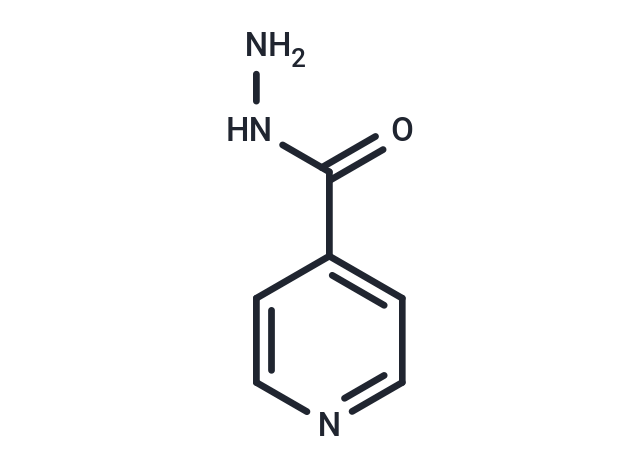Shopping Cart
- Remove All
 Your shopping cart is currently empty
Your shopping cart is currently empty

Isoniazid (Isonicotinic hydrazide) is an antibacterial agent used primarily as a tuberculostatic.

| Pack Size | Price | Availability | Quantity |
|---|---|---|---|
| 50 mg | $36 | In Stock | |
| 100 mg | $50 | In Stock | |
| 200 mg | $60 | In Stock | |
| 1 mL x 10 mM (in DMSO) | $48 | In Stock |
| Description | Isoniazid (Isonicotinic hydrazide) is an antibacterial agent used primarily as a tuberculostatic. |
| In vitro | Isoniazid is a prodrug that requires activation by the mycobacterial catalase-peroxidase enzyme (KatG) to an active form that then exerts a lethal effect on an intracellular target or targets. [1] Isoniazid upregulates the expression of an operon containing five FAS II components, including kasA and acpM. Isoniazid results in the accumulation of ACP-bound lipid precursors to mycolic acids that are 26 carbons long and fully saturated. [2] Isoniazid enters the mycobacterial cell by passive diffusion. Isoniazid itself is not toxic to the bacterial cell, but acts as a prodrug and is activated by the mycobacterial enzyme KatG, a multifunctional catalase-peroxidase that has other activities, including peroxynitritase and NADH oxidase. Isoniazid inhibits cell wall lipid synthesis, coupled with the findings that inhibitory INH adducts of NAD+/NADP+ are formed from the isonicotinoyl radical, leading the field away from this area. [3] Isoniazid induces a concentration-dependent (0-40 mM) cytotoxic effect in day-1 treated HepG2 cells and not significantly affected by decreases in intracellular GSH concentrations. [4] |
| In vivo | Isoniazid increases CYP2E1 protein, and the 6-hydroxychlorzoxazone formation rate is increased by 2.7 and 2.2-fold in liver and kidney, respectively. Isoniazid decreases liver and kidney 20-HETE content to 34% and 15.6% of control, respectively, without significantly altering tissue 19-HETE concentration. [5] |
| Alias | Isonicotinic hydrazide, Isonicotinic acid hydrazide, INH |
| Molecular Weight | 137.14 |
| Formula | C6H7N3O |
| Cas No. | 54-85-3 |
| Storage | keep away from direct sunlight | Powder: -20°C for 3 years | In solvent: -80°C for 1 year | Shipping with blue ice. | |||||||||||||||||||||||||||||||||||
| Solubility Information | DMSO: 26 mg/mL (189.6 mM) H2O: 25 mg/mL (182.3 mM) Ethanol: 26 mg/mL (189.6 mM) | |||||||||||||||||||||||||||||||||||
Solution Preparation Table | ||||||||||||||||||||||||||||||||||||
H2O/DMSO/Ethanol
| ||||||||||||||||||||||||||||||||||||

Copyright © 2015-2024 TargetMol Chemicals Inc. All Rights Reserved.